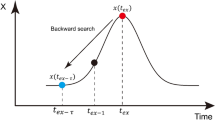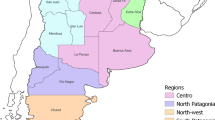Abstract
Heatwaves can have significant negative socioeconomic impacts and damage ecosystems. Consequently, accurate forecasts of such events are of great importance. In this study, the backward nonlinear local Lyapunov exponent (BNLLE) is used to investigate the local predictability of summer (June, July, and August) heatwave events over south China (SC). The predictability of the summer 2-m temperature (T2m) was quantified first. The results show that the summer T2m has a high predictability, and its predictability limit can reach 12 days, which is close to the upper limit of atmospheric predictability. Nine major heatwave events that occurred over SC were analysed, and their error dynamics and local predictabilities were studied using the BNLLE method. The local predictability limits covered a wide range, varying from 4 to 12 days. Analysis of the forecast error growth and associated rates revealed that the nine major heatwave events showed different error dynamics, thereby leading to the different local predictability limits. In addition, the regional dynamical information associated with these nine heatwave events was investigated and the error dynamics were found to have a heterogeneous spatial distribution. That is, both the error growth and their rates in the northern regions were larger than those in the southern regions. The regional dynamical information associated with the summer T2m also showed the same pattern. Therefore, the northern regions of SC are sensitive to error growth and limit the heatwave forecast skill.










Similar content being viewed by others
Data availability
The TIGGE (The Interactive Grand Global Ensemble) (https://apps.ecmwf.int/datasets/data/tigge/levtype=sfc/type=pf/). The ERA-interim analysis is from https://cds.climate.copernicus.eu/cdsapp#!/dataset/reanalysis-era5-single-levels?tab=form and (https://apps.ecmwf.int/datasets/data/interim-full-daily/levtype=sfc/), respectively.
References
Barlow KM, Christy BP, O’leary G, Riffkin P, Nuttall J (2015) Simulating the impact of extreme heat and frost events on wheat crop production: a review. Field Crop Res 171:109–119
Bougeault P, Coauthors (2010) The THORPEX interactive grand global ensemble. B. Am. Meteorol. Soc. 91:1059–1072
Craven M, Barnard A, Labuschagne MT (2007) The impact of cold temperatures during grain maturation on selected quality parameters of wheat. J Sci Food Agr 87:1783–1793
Dee DP, Coauthors (2011) The ERA-Interim reanalysis: Configuration and performance of the data assimilation system. Q J Roy Meteor Soc 137:553–597
Ding RQ, Li JP (2007) Nonlinear finite-time Lyapunov exponent and predictability. Phys Lett A 364:396–400
Ding R, Li J, Ha K-J (2008) Trends and interdecadal changes of weather predictability during 1950s–1990s. J Geophys Res 113:D24112. https://doi.org/10.1029/2008JD01040
Ding T, Qian W, Yan Z (2010) Changes in hot days and heat waves in China during 1961–2007. Int J Climatol 30:1452–1462
Ding RQ, Li JP, Seo KH (2011) Estimate of the predictability of boreal summer and winter intraseasonal oscillations from observations. Mon Wea Rev 139:2421–2438
Ding RQ, Li JP, Zheng F, Feng J, Liu DQ (2016) Estimating the limit of decadal-scale climate predictability using observational data. Clim Dyn 46:1563–1580
Duan WS, Mu M (2009) Conditional nonlinear optimal perturbation: applications to stability, sensitivity, and predictability. Sci China Ser D 52:883–906
Farrell BF (1990) Small error dynamics and the predictability of atmospheric flows. J Atmos Sci 47:2409–2416
Freychet N, Tett S, Wang J, Hegerl G (2017) Summer heat waves over eastern China: dynamical processes and trend attribution. Environ Res Lett 12:024015
García-León D, Casanueva A, Standardi G, Burgstall A, Flouris AD, Nybo L (2021) Current and projected regional economic impacts of heatwaves in Europe. Nat Commun 12:1–10
Gruber S, Hoelzle M, Haeberli W (2004) Permafrost thaw and destabilization of Alpine rock walls in the hot summer of 2003. Geophys Res Lett 31:L13504. https://doi.org/10.1029/2004GL020051
Ham Y-G, Kim J-H, Luo J-J (2019) Deep learning for multi-year ENSO forecasts. Nature 573:568–572
He W, Feng GL, Dong W, Li J (2006) On the predictability of the Lorenz system. Acta Physica Sinica 55(2):969–977
He W, Xie X, Mei Y, Wan S, Zhao S (2021) Decreasing predictability as a precursor indicator for abrupt climate change. Clim Dyn 56:3899–3908
Hochman A, Scher S, Quinting J, Pinto JG, Messori G (2021) A new view of heat wave dynamics and predictability over the eastern Mediterranean. Earth Syst Dynam 12:133–149
Hou W, Coauthors, (2014) Climatic characteristics over China in 2013. Meteorol Mon (in Chinese) 40:482–493
Hu K, Huang G, Qu X, Huang R (2012) The impact of Indian Ocean variability on high temperature extremes across the southern Yangtze River valley in late summer. Adv Atmos Sci 29:91–100
Hu L, Huang G, Qu X (2017) Spatial and temporal features of summer extreme temperature over China during 1960–2013. Theor Appl ClimatoL 128:821–833
Katsafados P, Papadopoulos A, Varlas G, Papadopoulou E, Mavromatidis E (2014) Seasonal predictability of the 2010 Russian heat wave. Nat Hazard Earth Sys 14:1531–1542
Lacarra JF, Talagrand O (1988) Short-range evolution of small perturbations in a barotropic model. Tellus A 40:81–95
Lee HJ, Lee WS, Yoo JH (2016) Assessment of medium-range ensemble forecasts of heat waves. Atmos Sci Lett 17:19–25
Lee H-J, Lee W-S, Chun JA, Lee HW (2020) Probabilistic heat wave forecast based on a large-scale circulation pattern using the TIGGE data. Wea Forecasting 35:367–377
Leutbecher, and T. N. Palmer, (2008) Ensemble forecasting. J Comput Phys 227:3515–3539
Li JP, Ding RQ (2011) Temporal–spatial distribution of atmospheric predictability limit by local dynamical analogs. Mon Wea Rev 139:3265–3283
Li X, Ding R (2022) The backward nonlinear local Lyapunov exponent and its application to quantifying the local predictability of extreme high-temperature events. Clim Dyn. https://doi.org/10.1007/s00382-022-06469-w
Li X, Ding R, Li J (2019) Determination of the backward predictability limit and its relationship with the forward predictability limit. Adv Atmos Sci 36:669–677
Li X, Ding R, Li J (2020) Quantitative study of the relative effects of initial condition and model uncertainties on local predictability in a nonlinear dynamical system. Chaos Soliton Fract 139:110094
Li X, Ding R, Li J (2022) A New technique to quantify the local predictability of extreme events: the backward nonlinear local lyapunov exponent method. Front Env Sci-Switz. https://doi.org/10.3389/fenvs.2022.825233
Li D, Hu S, He W et al (2022) The area prediction of western North Pacific Subtropical High in summer based on Gaussian Naive Bayes. Clim Dyn. https://doi.org/10.1007/s00382-022-06252-x
Lorenz EN (1963) Deterministic Nonperiodic Flow. J Atmos Sci 20:130–141
Lorenz EN (1969a) Atmospheric predictability as revealed by naturally occurring analogues. J Atmos Sci 26:636–646
Lorenz EN (1969b) Three approaches to atmospheric predictability. Bull Am Meteorol Soc 50:345–351
Lu C, Coauthors, (2020) An unusual heat wave in North China during midsummer, 2018. Front Earth Sc-Switz 8:238
Matsueda M (2011) Predictability of Euro‐Russian blocking in summer of 2010. Geophys Res Lett 38:L06801. https://doi.org/10.1029/2010GL046557
Mohammed AR, Tarpley L (2009) Impact of high nighttime temperature on respiration, membrane stability, antioxidant capacity, and yield of rice plants. Crop Sci 49:313–322
Mu M, Duan W (2003) A new approach to studying ENSO predictability: conditional nonlinear optimal perturbation. Chin Sci Bull 48:1045–1047
Mu M, Duan W, Wang B (2003) Conditional nonlinear optimal perturbation and its applications. Nonlinear Proc Geoph 10:493–501
Mu M, Zhou F, Wang H (2009) A method for identifying the sensitive areas in targeted observations for tropical cyclone prediction: conditional nonlinear optimal perturbation. Mon Weather Rev 137(5):1623–1639
Nese JM (1989) Quantifying local predictability in phase space. Physica D 35:237–250
Poumade`re M, Mays C, Le Mer S, and B. R, (2005) The 2003 heat wave in France: dangerous climate change here and now. Risk Anal 25:1483–1494
Qian C, Yan Z, Wu Z, Fu C, Tu K (2011) Trends in temperature extremes in association with weather-intraseasonal fluctuations in eastern China. Adv Atmos Sci 28:297–309
Ratnam J, Dijkstra H, Behera SK (2020) A machine learning based prediction system for the Indian Ocean Dipole. Sci Rep UK 10:1–11
Ren Y, Parker D, Ren G, Dunn R (2016) Tempo-spatial characteristics of sub-daily temperature trends in mainland China. Clim Dyn 46:2737–2748
Russo S, Coauthors, (2014) Magnitude of extreme heat waves in present climate and their projection in a warming world. J Geophys Res-Atmos. https://doi.org/10.1002/2014JD022098
Schaller N, Sillmann J, Anstey J, Fischer EM, Grams CM, Russo S (2018) Influence of blocking on Northern European and Western Russian heatwaves in large climate model ensembles. Environ Res Lett 13:054015
Su X, Yuan H, Zhu Y, Luo Y, Y. J. J. o. G. R. A. Wang, (2014) Evaluation of TIGGE ensemble predictions of Northern Hemisphere summer precipitation during 2008–2012. J Geophys Res-Atmos 119:7292–7310
Swinbank R, Coauthors, (2016) The TIGGE project and its achievements. B Am Meteorol Soc 97:49–67
Van den Dool HM (1994) Searching for analogues, how long must we wait? Tellus 46A:314–324
Wang Q, Zhong W, Yang S et al (2022) Southern China winter rainfall modulated by South China Sea warming. Geophys Res Lett 49(5):e2021GL097181
Wang Q, Zhang B, Zeng L et al (2022) Properties and drivers of marine heat waves in the Northern South China Sea. J Phys Oceanogr 52(5):917–927
Xu H, Chen L, Duan W (2021) Optimally growing initial errors of El Niño events in the CESM. Clim. Dyn 56:3797–3815
Yeo SR, Yeh SW, Lee WS (2019) Two types of heat wave in Korea associated with atmospheric circulation pattern. J Geophys Res-Atmos 124:7498–7511
Yoden S, Nomura M (1993) Finite-time Lyapunov stability analysis and its application to atmospheric predictability. J Atmos Sci 50:1531–1543
Acknowledgements
We would like to thank Dr. Jie Feng for the discussion. This work is based on TIGGE data. TIGGE (The Interactive Grand Global Ensemble) is an initiative of the World Weather Research Programme (WWRP). This work was jointly supported by the National Natural Science Foundation of China (Grant Nos. 42005054, 42288101 and 41975070), China Postdoctoral Science Foundation (2020M681154) and the Science and Technology Commission of Shanghai Municipality (20dz1200700).
Funding
This work was jointly supported by the National Natural Science Foundation of China (Grant Nos. 42005054,42288101 and 41975070), China Postdoctoral Science Foundation (2020M681154) and the Science and Technology Commission of Shanghai Municipality (20dz1200700).
Author information
Authors and Affiliations
Contributions
The first draft of the manuscript was written by XL. RD and JL commented on initial versions of the manuscript. All authors have read and approved the final manuscript.
Corresponding author
Ethics declarations
Conflict of interest
The authors have no relevant financial or non-financial interests to disclose.
Additional information
Publisher's Note
Springer Nature remains neutral with regard to jurisdictional claims in published maps and institutional affiliations.
Rights and permissions
Springer Nature or its licensor (e.g. a society or other partner) holds exclusive rights to this article under a publishing agreement with the author(s) or other rightsholder(s); author self-archiving of the accepted manuscript version of this article is solely governed by the terms of such publishing agreement and applicable law.
About this article
Cite this article
Li, X., Ding, R. & Li, J. Estimating the local predictability of heatwaves in south China using the backward nonlinear local Lyapunov exponent method. Clim Dyn 61, 3605–3618 (2023). https://doi.org/10.1007/s00382-023-06757-z
Received:
Accepted:
Published:
Issue Date:
DOI: https://doi.org/10.1007/s00382-023-06757-z




